Long load times.
Graphics intensive page due to loading of photos and slide shows. Please be patient...
8th ATTACK SQUADRON ASSOCIATIONKUNSAN AIRBASE 8th BOMB SQUADRON (L-NI)
(1951-1954)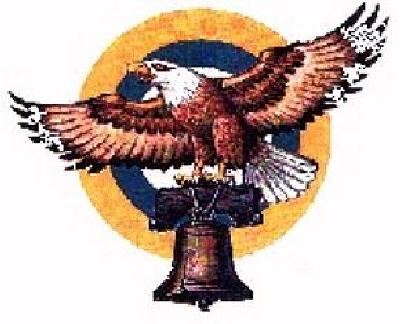 Page 3 of 4 |
 - Squadron Insignia
- World War I and between the Wars (1917-1941)
- World War II (1941-1945)
- Occupation Forces in Japan -- Convert to B-26
- Korean War
- After the Korean War -- Johnson AB (1954-1960) and Yokota AB (1960-1964). Convert to B-57Bs (1957) with nuclear alerts at Kunsan AB (1958-1964)
- Vietnam -- 3rd Bomb Wing (Tactical) goes to Florida to convert to F-100s. Last B-57 squadrons in USAF get a reprieve from deactivation. B-57s to Vietnam: 8th & 13th attached to 41st AD and 2nd AD. (1964-1969).
 8th Bombardment Squadron (L-NI)
Kunsan Air Base (K-8)
(1951-1954) |
Acknowledgment: Special thanks to Hans Petermann of San Diego, California for his technical notes on the B-26, photos and narratives that are used throughout the site. Also thanks to Jack Boyer of Santa Clarita, California for his photos and narratives to this section. Also thanks to Dave Bradburn for his narratives. We are extremely grateful to Al Gould for his narratives, commentary and photos. Thanks to Harold Locke for his photos. Thanks to Larry Casseria for his narratives and photos. Thanks to Paul T. Ono for his narratives. Thanks to Craig Hinton for his photos of the post-Korean years in Korea. In addition, we wish to express our gratitude to the late Jack Barclay of Bohemia, New York for his photos, maps and other invaluable reference materials. (Godspeed, Jack!) Thanks to the marvelous historical site of the 3rd Wing History Office of Elmendorf AFB, AK for its historical materials. We are deeply indebted to the Joe Baugher website for its wealth of historical information on aircraft.  8th Bomb Squadron insignia 8th Bomb Squadron insignia
Approved June 21, 1954

 8th Bombardment Squadron (L-NI):
Night FlyingThe night flying missions of the 8th aided in tallying up some incredible figures for locomotive and vehicle "kills". North Koreans found it almost suicidal to move large vehicle convoys by day. When they did attempt it, marauding fighter-bombers, chopped the convoys to pieces. Moving large convoys at night seemed the only sensible choice, so the North Koreans began hauling their supplies under the cover of darkness. Rail traffic also took to moving at night, speeding from one tunnel to another until dawn. But night flying was a dangerous undertaking. The North Koreans knowing they had to protect their truck convoys placed flak batteries on hills and mountaintops that overlooked crucial road routes. At times, the gunners actually had to fire down into the valleys to hit the attacking B-26s. These flak traps could be deadly, and their plunging fire claimed many B-26 lives.
Crimson Sky -- The Air Battle for Korea by John R. Bruning (pp. 112-113) contains some enlightening information on the dangers of night flying. He wrote, "At the same time, some convoys began carrying their own organic light anti-aircraft weapons, machine guns being the most common. The North Korean s stationed observers every few hundred yards along their supply routes to warn passing trucks of danger. When a lookout sounded the alarm, the convoy halted and deployed its air defense systems. The B-26s usually had time to make only one pass before the guns were ready for action. After that, the Invader would be facing an alerted and frequently well-armed enemy."
"As a result of these tactics, night intruder missions became increasingly hazardous. Even stopping a convoy, which most B-26s tried to do by knocking out the lead truck to block the road, became increasingly dangerous. ... Attacking "down the string" -- parallel along the convoy's length -- was the most effective way to knock out road traffic, but it also became one of the most dangerous. Light anti-aircraft guns posted with the convoys could get a near zero deflection shot on the Invaders attacking down the string, which made them easy to hit."
He went on to say, "As though flak and small arms weren't enough, the North Koreans stretched thick cables across some valleys. Unable to see them in the dark, marauding FEAF aircraft sometimes collided with the cables and were destroyed or heavily damaged."
One would would imagine that flying with moonlight would be a blessing to increasing the pilot's visibility. However, the paradox was that moonlight posed a problem. An HQ FEAF (UP) article (undated 1952) read, "Moonlight Missions, Tougher Targets, For Fifth Air Force. -- Fifth Air Force pilots on night missions over Korea are having a tough time seeing enemy trucks -- there's too much moonlight. The answer is simple. Communist truckers take advantage of the moonlight to drive without lights and to hide in the shadows of ravines and roadside trees." The article continued, "The situation has its good points, however. Communist locomotives, which can run without headlights on dark or moonlit nights, become sitting ducks on moonlight nights. The steam from the engines is a pale, fluffy giveaway." The article went on to say, "On a dark night when the moon is in its quarters or there is no moon at all, Red vehicles take a beating. Poor roads, with sharp turns and bomb blasted shoulders, are death traps for the driver who doesn't use his headlights. Those tell-tale beams locate his position for Night Intruder pilots."  8th Year Book (Jul-Dec 52) 8th Year Book (Jul-Dec 52)
Click on photo to enlargeBuddies; Modeling heated suit
(Courtesy Harold Locke) (Click on photo to enlarge)(NOTE: In the photos above, Don Amik wrote, "I visited the How It Was! Kunsan Airbase page and was surprised to see a couple of old colleagues from K-8 in one of the photographs. They are the only two unidentified airmen in photo 49, captioned "Buddies." The tall airman on the left is Jake Wallace from Tennessee and the fellow next to him is George Adams from Texas. Both were assigned to 3d Bomb Group intelligence, as was I. Jake was on the 8th Squadron roll and George, I think, was 90th, although I'm not absolutely certain. I was in the 13th. We did debriefings during the spring and summer of 1952. Jake was recalled stateside late in the summer but George and I served a full year's hitch. I went on to instruct at USAF intelligence school at Lowry AFB and later at Sheppard AFB before being discharged in March 1955." Jake Wallace and George Adams were with 3d Bomb Group intelligence.)
An excellent account of a night bombing/strafing run by a B-26 is given in the Crimson Sky -- The Air Battle for Korea by John R. Bruning (pp. 105-106) . It recounts a mission by Captain Richard "Dick" M. Heyman, Jr. of the 8th Bomb Squadron (L-NI) where he destroyed or damaged more than 100 vehicles. (Normally a convoy was only 12-15 trucks.) He was in the 8th BS from April 1951 thru Nov 1951 stationed at Iwakuni, Japan and Kunsan, Korea as a flight commander and assistant Ops Officer. The books said, "The Douglas B-26 Invader darted down the valley, its aluminum skin catching the moonlight as it raced along. Below, a narrow crushed-rock road wound its way around the valley's low foothills. The B-26 continued along, following the road unit it opened into a flat, wooded area part way up the valley."
"At the Invader's controls, Captain Dick Heyman peered out of the canopy to look for movement on the road below. He banked the wing slightly, moving off his current course. As he did, he caught sight of a pair of lights on the road beyond his wing. He fixed the lights' position relative to a couple of local landmarks. That way, should they go out, he would still have an idea of where he had seen them."
"He flew beyond the lights and saw that they came from one of two trucks moving slowly out of the wooded area. As he flew past them, he noticed many more trucks behind the one with the headlights. In fact, the wooded area below seemed to be some sort of bivouac. Trucks parked tightly together under the trees. Obviously, he had just caught them forming up for the trip south."
"Extending beyond his target area, Dick opened the throttles. A few miles later, he banked sharply and the B-26 nimbly responded to his control inputs. Now, as he roared back, the bomber's two Pratt & Whitney R-2800 engines echoed off the hills surrounding the valley. Surely, the sentries on the ground could hear him coming."
"He followed the road south back to the wooded area, opening his bomb bay doors as he approached. There were no lights below now, but he pin-pointed the area well. He thundered over it, laying a string of bombs behind him. Their shrill whistles spelled doom for scores of men below, trapped in their encampment with no escape from the aerial attack."
"Dick pulled up. He'd been under 500 feet when he made his run, and his B-26 was picking up light flak from the alerted enemy below. Behind him, his bombs began to explode, lighting the night with their reddish-orange glow. He could see the carnage his pass had caused. Dozens of trucks had been caught by his bombs. Shrapnel had gashed their sides, splitting open fuel tanks and loads of ammunition stored in their beds. Gasoline fires erupted as fuel tanks brewed up. Ammunition began to cook off, adding a sort of Fourth of July atmosphere to the scene as tracers zipped in random directions."
"Dick made another run up the valley as he held the B-26 steady despite the 23-mm anti-aircraft fire dotting the night sky around him. When he reached the wooded area, he unleashed his eight fixed 50-caliber machine guns while his gunner swept the area with the turret guns. Trucks, men, and equipment alike simply dissolved under the withering strafing attack. Dick walked the rudder back and forth, hosing down the wooded area, the 50s tearing apart everything in their path."
"Just a few feet off the deck, the Invader streaked over the burning North Korean bivouac at more than 300 mph. In its wake, it left a scene of utter devastation swathed in smoke and flame. Later, a reconnaissance RB-26 photographed the area and gave Dick Heyman credit for one hundred vehicles destroyed or damaged." |
 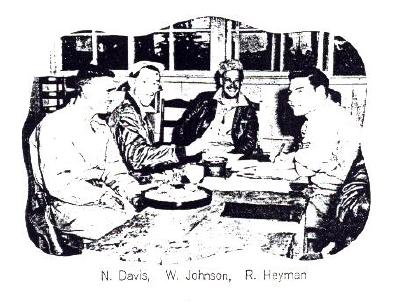 Right: Heyman, Murphy and Morello Right: Heyman, Murphy and Morello
N. Davis, W. Johnson, and R. Heyman
(1951 Yearbook)
Click on photo to enlargeHans Petermann wrote, "...I knew Dick Heyman and flew a mission with him out of K-8. Had to be late Sept or early Oct 51. Did you know that he was credited with shooting down a North Korean "Bathtub"? The following is from an earlier
squadron book, which was primarily about Iwakuni. ..." "THE CASE OF THE FLYING BATHTUB"
On June 23 Captain Dick Heyman, 8th Bomb Squadron
pilot was returning from his target area. Heyman had damaged five trucks
in a 20 vehicle convoy heading north into Wonsan before his fuel supply
ran low, when he departed the area for his home base.
The navigator, 1st Lt Walton E. Johnson had given
him a heading through the bombline and at the moment the return to base
appeared as though it would be uneventful. Then....shades of flying
saucers!.....A ground controller was heard calling for a UN plane in the
Seoul area to flush an unidentified enemy aircraft. Heyman, being an old
fighter pilot, perked up his ears, grabbed his "mike" and offered his
services. The ground controller directed him to head to a point
approximately 25 miles northeast of Kimpo, descend to 2000' while
slowing the aircraft, repeat....slowing the aircraft down to 100 miles
per hour. Lieutenant Johnson hurriedly computed a heading for this area,
then Heyman shoved everything to the firewall and the 8th ship was off
to the races at 275 miles per hour.
When Dick reached the area the ground controller
told him the "Bogie" was in the immediate vicinity. Now the only problem
remaining was to find him, and give him a shot in the head gasket. On
his way to find the enemy aircraft Heyman started to review what the
ground controller had said. He had a sneaking suspicion that he was
looking for a flying washtub if he had to slow down to 100 miles per
hour to catch this guy, but what the hell....a planes a plane, and Dick
didn't plan to miss this enemy aircraft.
In the bright moonlight, Heyman and his crew saw the
plane. By this time, Dick was cruising around with full flaps, wheels
down, bomb-bay doors open and cowl flaps cracked. Still, he couldn't
slow down less than 130. At this precarious airspeed they went 'round
and 'round after the bogie. They could see that the enemy plane was a
Bi-plane type craft and probably fabric-covered. For about 15 minutes
the 8th ship played hide and seek with the other plane. When they first
saw him he was strafing, but he soon realized he was being tailed and
made every effort to get away.
Heyman had a pretty tough time staying on this
bird's tail. His airspeed, reduced to dangerous limits was still a
Sukoshi too much. Finally Dick got his chance to fire at the "Bogie".
They were charging down a valley at about 800' when Heyman overtook the
enemy plane from the side and made a 90 degree deflection shot while
standing on a wingtip. There was a bright flash of light and a complete
disintegration as the ship blew to pieces. Thus Captain Heyman was the
first pilot in the Third Bomb Group to get credit for shooting an enemy
aircraft out of the sky during this Korean war.
Dick and his jubilant crew landed at an airfield in
Korea to refuel. While there, they were informed that ground control had
verified their "kill" and so they returned to their base in triumph. We
sure are proud of your night's work Captain Heyman. S Sgt Norman Davis,
your gunner, is somewhat envious, but no less proud.
During World War II, Captain Heyman received credit for one enemy aircraft destroyed in air to air combat, and also one
damaged. Keep it up Dick, you can still become an Ace, 'cause now you
have a total of two destroyed! |
But the night flying also included hunting for locomotives. The Korean conflict bred a new type of ace -- a "Loco Ace." He was a person who destroyed five enemy locomotives. A locomotive was a juicy prize. Hans Petermann remembers his last mission bombing a rail yard . "Capt. Arlo Potter, pilot; A/2c John Hubbard, gunner; and I, as navigator/bombardier/radar operator, had trained together as a crew at Langley AFB but flew out of K-8 together on missions only three times. The last was our 55th and Arlo thought we should finish together. I didn't know he had turned out to be a tiger in the worst way. (NOTE: A "tiger" is an aggressive pilot with the quality to bore in for the "kill".) We were working the route know as Purple 5 between Huichon and Kanggye in a C-model B-26 with me in the nose and a "green" pilot (it was his 3rd mission) in the right seat. It was a nice, clear moonlight night with good visibility. We spotted four live locos in the rail yards at Huichon and thought, "Boy here is a nice fat one for our swan song." So what happened? Our wiring circuits were fouled up and we couldn't get our bombs out when we wanted to during several passes, which in itself was a no-no. We had to salvo our load in disgust into the yards. We couldn't see what happened so Arlo said that he would make a low-level pass over the yards with our landing lights on. We did and I thought the "green" pilot would pass out, right after me. No reaction from John in the rear. The boys on the ground weren't dumb and they unloaded on us, but to no avail. But with all the smoke and goings-on, we couldn't see the results. Arlo and I were fit to be tied. The fattest targets we had seen in the whole 55 (missions) and we couldn't do any good." 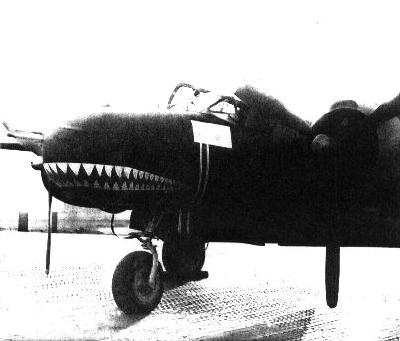 Old 300 Old 300
(Pilot: Arlo Potter/Nav: Hans Petermann/Gunner: John Hubbard)
(Courtesy Hans Petermann)
Click on photo to enlarge
Kunsan Landing View from the Right Seat
(Courtesy Harold Locke)
(Click on thumbnails to enlarge)
Aerial views: Bombed out bridge; Kum River; Aerial view of Seoul;
B-26 in formation; Periscope view; Bomb bay view
(Courtesy Harold Locke)
(Click on thumbnails to enlarge)Sometimes the crews fudged a bit on the debriefs when describing their kills. For a B-26 crew to claim a truck as destroyed, the vehicle had to "explode or burn with a sustained fire." No reports were made or records kept on "damaged" vehicles. Hans recalled, "On another night in a B-model with me in the right seat and a pilot from the 8th, we were patrolling the route between Haeju and Sariwon. For the first and only time for me, we were armed with underwing rockets. It was fairly hazy so the visibility was restricted and we had to be careful of our location in regard to the terrain. We finally spotted several trucks on the highway and started our attack. The haze made it difficult for the pilot to spot his targets but he made several passes with the rockets. They were something else when they went off. We were never positive that we destroyed the vehicles, but the pilot philosophized that we had better claim something or they would never let us use rockets again. So we claimed four trucks."
According to South to the Naktong, North to the Yalu (p.379), "While it is clear that air power wrought great destruction of enemy equipment and troops during this period of the war, it is not possible to state accurately just how great it really was. Pilot claims are the basis of most estimates of air damage and destruction. Experience has shown that these are subject to many kinds of error. As an example, pilots often mistakenly claimed the destruction of enemy equipment if it remained immobile after attack. It is often impossible for a pilot of a high-speed aircraft to determine if his target is live or not, and three or four different pilots may claim as a "kill" a vehicle already knocked out by ground action. One study revealed a surprisingly great discrepancy between pilot claims and a ground study of destroyed enemy equipment. Pilots claimed to have destroyed ten times as many tanks with rockets as with napalm in the first three months of the Korean War, but a ground survey of destroyed enemy tanks after the Eighth Army breakout from the Pusan Perimeter showed three times as many tanks destroyed with napalm as with rockets. This gives a discrepancy factor of thirty to one in relation to pilot claims. Napalm seldom destroyed a tank by the burst of flame itself. But it did set off chain events that often led to the complete destruction of the tank. The splashing napalm on the bogie wheels set the rubber tires on fire, it heated ammunition to the point where it detonated inside the tank, or it set fuel on fire, and sometimes it splashed into the air intake vents and started fires inside the tank."  Capt John Pauley (later a 4-star USAFE Commander) Capt John Pauley (later a 4-star USAFE Commander)
having his picture taken by 1Lt Al Connor (1952)
(NOTE: "Rush's Renegades" on the sign refers
to Lt. Col. Stan V. Rush, the 8th's Commander.
The Indian was his mascot.)
(Courtesy Hans Petermann)
Click on photo to enlargeAlso there was a bit of professional rivalry between the squadrons...and sometimes, it was obvious that "kills" that were reported back to base weren't always true. On another mission, Hans recalled, "1st Lt John Schmitt from the 8th Squadron and I were in a B-model, with me in the right seat, one night working the route between Sariwon and Pyongyang. It was clear and bright with a full moon and lots of snow on the ground so visibility was excellent. We couldn't find any traffic on our route but heard a plane from another squadron reporting that he had attacked a train on their route north of Chinampo. After they called in and cleared the area John called in and received permission to go to that area for a look-see. We easily spotted the train - standing still, a locomotive with several open, empty gondola cars with snow in them and a caboose. No signs of any damage. John immediately made several very low passes at the train with no visible signs of success. We finally left after expending all our ordnance with the train still on the tracks. We reported to our outbound controller the map coordinates of the train and the negative results. There was a long pause and then a request for confirmation of the coordinates. This was given and then another pause. Back came, "That train was reported destroyed with fires and explosions by so-and-so of the so-and-so squadron". John exploded. "That train is still on the tracks with snow in open gondola cars, so I know there were no fires." We received the same dubious response during out debriefing. The next day we were chewed out for dropping our bombs too low as evidenced by bomb fragments in the bottom of our airplane. The type we carried were not supposed to have been released below 500 ft. I obtained, and still have, one of the fragments as a souvenir."  B-26 Invader B-26 Invader
(Courtesy Jack Barclay)
Click on photo to enlargeThe narrative above also illustrates the differing viewpoints of an aircrew member versus maintenance crew chief. Hans speaks of his "souvenir" with pride but we can just imagine the cussing of the crew chief as he discovered the holes in his airplane from those "@#$%^&* flight jocks" dropping their ordnance too low AGAIN! The 8th's Squadron Yearbooks spanning the Korean War years are filled with cartoons depicting this friendly conflict. In one 1952 cartoon, we see a B-26 in the background with the wheel struts protruding through the top of the wings and nose with all the tires flat. Off to the side, we see one crew chief weeping in despair and another howling mad. In the meantime, the pilot is casually smoking a cigarette next to his aircraft and says, "I won't write it up, but check for a hard landing."  Lt. Ben Kouns at Runway Control (1951) Lt. Ben Kouns at Runway Control (1951)
(Courtesy Al Gould)
Click on photo to enlarge |  Runway Control (1951) Runway Control (1951)
(Courtesy Al Gould)
Click on photo to enlarge |
But those maintenance crews -- working under the extreme weather conditions of Kunsan -- performed miracles to have a safe aircraft ready for the next flight. However, periodically electrical or mechanical malfunctions would cause an inflight emergency. Hans remembers, "One night I was flying in the back of a C-model as radar operator. On climbout after take-off I smelled gas fumes and reported it to the pilot. A few minutes later it was worse and I reported to the pilot that I was going on 100% oxygen. He immediately became concerned and asked for further information. At that point my interphone transmission went out and I couldn't respond. Nothing I tried restored communication with him over the phones. I could hear him and the rest of the crew and he became worried that I had passed out from the fumes. He initiated a return to base and told everyone not to activate any switches. I finally thought of trying to communicate by flashlight. I could see the engine props from my windows and I started flashing my light on them. After several tries the pilots saw the flashes. We would then communicate by my flashing on the left prop for a "yes" to his question and on the right prop for a "no." He was then satisfied that I was OK but that the excessive fumes situation still existed. We landed back at K-8, pulled off the runway and shut down. Emergency personnel arrived and when the bomb bay doors were opened, gasoline poured from the bays. I'd say we were lucky nothing worse happened. We debriefed and thought that our night was finished and that we could avail ourselves of a post-mission "relaxer." No such luck. We were assigned the back-up plane and went ahead with a full mission."  Jack Barclay (1953) Jack Barclay (1953)
(Courtesy Jack Barclay)
Click on photo to enlarge
Flyers who face death as a daily routine sometimes view danger in a somewhat different sense than the rest of the earth-bound souls. Jack Barclay of Bohemia, New York (a Flight Engineer with the 8th) mentioned an incident that occurred when the runway was being extended in 1953. He was on a checkflight with a new Colonel whose landing was a little low and short. As the aircraft was approaching touchdown, the good folks of the 808th Engineering Aviation Battalion who were building the runway extension started diving for cover. Jack casually remarked that "they weren't in any danger." I don't think 808th EAB folks shared his view, but at least they learned what the North Koreans felt like during a low-level pass by a B-26.
Jack flew his 50th combat mission on July 24, 1953 -- three days before the Armistice. He remembers most those beloved words that aircrews cherished..."FIGMO" (F_ _ k it I got my orders). Hans Petermann was at Kunsan from Sept 51 to May 52. He stated that "in his time frame the mission tour was 50, later dropped to 25, while it was 55 when I was there." Voron N. Baughan wrote about the early days of the war, "Who said anything about how many missions, etc. -- This had turned into a "war." However, this was being considered & it needed to happen. I had heard 25, 50, but as it turned out for some -- 50 missions was it, but NOT under it. There was no guarantee for anyone." Pat M. Smith of Milw, Oregon wrote, "Everybody that flew combat '52 thru to early 1953 had to fly 55 combat missions to get the combat crew "dealie bob" and able to "fly" home when FIGMO."

8th Beer Mug -- Fifty Mission Souvenier Russell Drawz wrote, "Here's a picture of my " beer" Mug. It was given when you finished your 50th mission. But it was filled with whiskey, not beer, and you did not leave the party until you drank it all." Every unit in Korea had their own "traditions" -- with most of them revolving around the sport of "social" drinking. However, this 50th mission toast doesn't appear to have caught on as a "tradition" with others. David Delano of La Jolla, CA, stated that he had the mug made in Japan, 100 of them, and kind of apologizes for the design, particularly the female handle. He attributes it to the fact that he was only 27 at the time and that is rather what was done then. He was with the 8th in the early part of 1952 and came home in the latter part of 1952. However, he wasn't aware of the 50 mission "award." David stated that though he was at K-8 in 1952, he added the "1951-1952" statement to the mug to cover those who were with the unit in 1951.

Orderly Room Sign (1953) (Ron Kunz)The Slide Show photos by Ron Kunz of Daytona Beach, FL during his tour in 1952-1953.As a final note, Jack Barclay recalled a bit of B-26 aircrew humor, "One crew was on a mission up in North Korea when all of a sudden a lot of flak came up & lit the sky up like the 4th of July. The pilot very wisely lowered his seat & started flying on instruments so that his night vision wouldn`t be compromised. Well, the guy who was in the right seat looked over & said to the pilot, 'Get your head up out that hole & see where you're going.'"
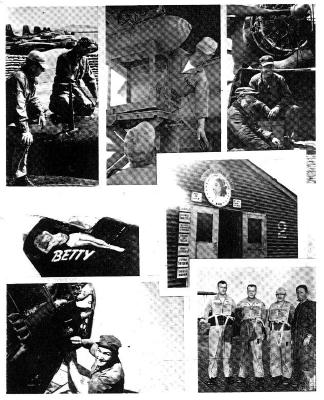 8th Year Book (Jan-Jul 53) 8th Year Book (Jan-Jul 53)
Click on photo to enlarge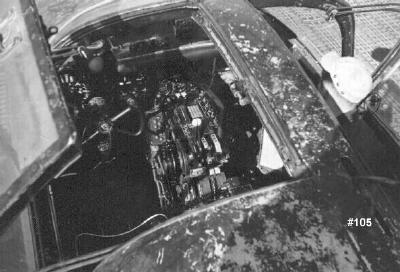
B-26 Cockpit
(Courtesy Harold Locke)
(Click on thumbnails to enlarge)
For inputs or comments, contact Kalani O'Sullivan.NOTICE/DISCLAIMER: The content of this page is unofficial and the views and opinions expressed do not necessarily reflect those of anyone associated with this page or any of those linked from this site. All opinions are those of the writer and are intended for entertainment purposes only. Links to other web pages are provided for convenience and do not, in any way, constitute an endorsement of the linked pages or any commercial or private issues or products presented there.
For inputs or comments, contact Kalani O'Sullivan.NOTICE/DISCLAIMER: The content of this page is unofficial and the views and opinions expressed do not necessarily reflect those of anyone associated with this page or any of those linked from this site. All opinions are those of the writer and are intended for entertainment purposes only. Links to other web pages are provided for convenience and do not, in any way, constitute an endorsement of the linked pages or any commercial or private issues or products presented there.
Copyright 2003 - All Rights Reserved
email to: kalani@hanvit.com

FastCounter by bCentral
|

